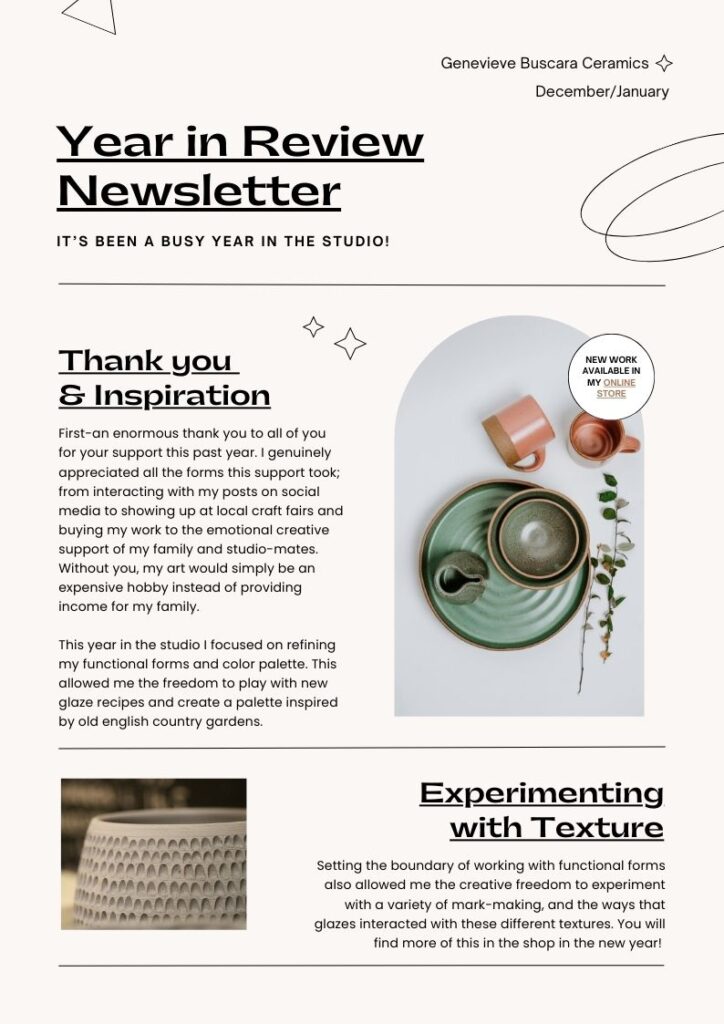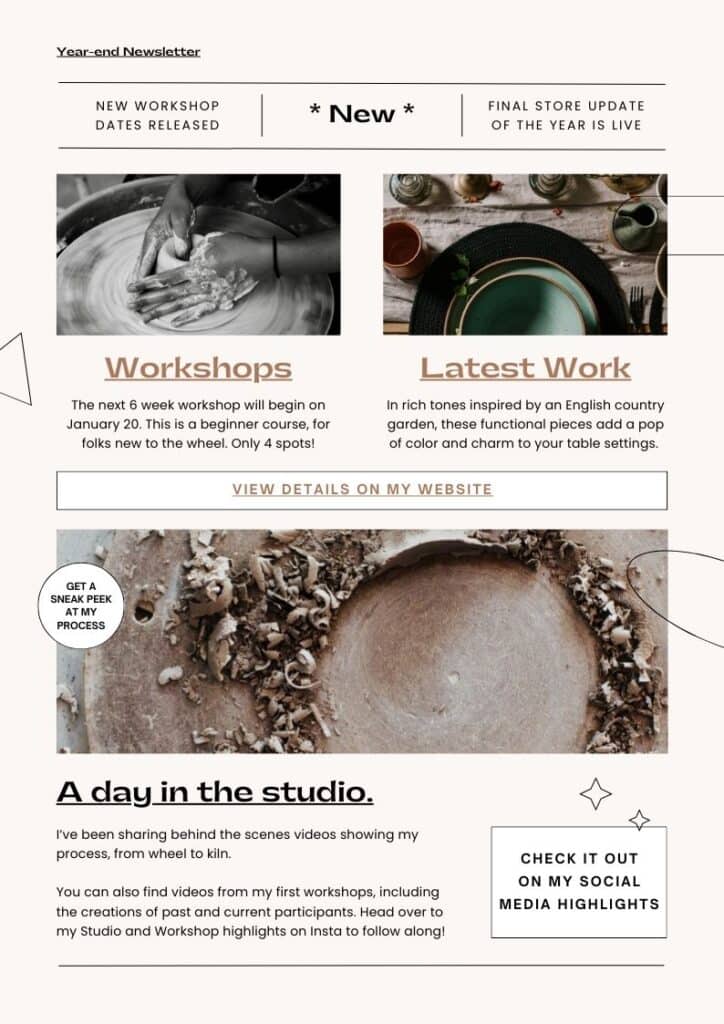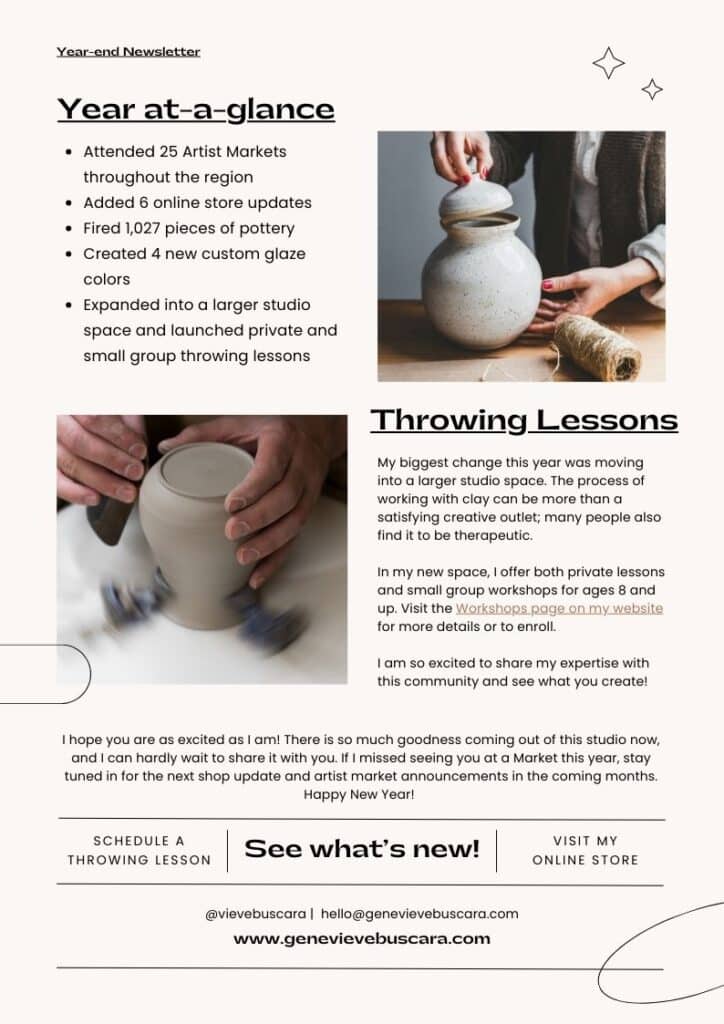E-Mails zum Jahresende sind ein effektiver Weg, um mit deinen Kunden und Verteilern zu kommunizieren - also mit Menschen, die in deine kreativen Ambitionen investiert haben, über dein Wachstum in diesem Jahr. Tatsächlich sind E-Mails zum Jahresende wahrscheinlich eines der am wenigsten genutzten und kosteneffektivsten Marketinginstrumente, die Kreativschaffenden zur Verfügung stehen, da sie überdurchschnittlich häufig genutzt werden.
Das ganze Jahr über kann die Kundenkommunikation viele verschiedene Formen annehmen. Beantworte Anfragen von potenziellen Kunden, führe Feedback-Umfragen durch, Marketing für besondere Veranstaltungen oder Updates im Ladenund das Versenden von persönlichen Notizen mit einer Bestellung sind Beispiele für Kundenkommunikation. Deine aktuellen und potenziellen Kunden sind Teil deiner Mailingliste, weil sie das Fachwissen und die persönliche Note eines unabhängigen Kreativprofis wie dir schätzen. Effektive Kundenkommunikation, wie z.B. eine E-Mail mit den Highlights zum Jahresende, hat die Kraft, die Beziehung zu deinen Kunden zu stärken.
Effektive Kundenkommunikation
Wenn es um Kundenkommunikation geht, ist Qualität wichtig. Die Menschen sind in ihrem täglichen Leben der Kommunikation von Marken ausgesetzt, bis hin zu 50-400 Anzeigen pro Tag durch Anzeigen allein. Anders als bei Anzeigen entscheiden sich die Kunden dafür, dass sie Kommunikation von dir erhalten, was bedeutet, dass sie wollen von dir hören.
Wie kann ein Kreativprofi also den Lärm durchbrechen? Beginne mit ein wenig Planung und Voraussicht bei den folgenden Überlegungen:
Klare Ziele formulieren
Zu Beginn ist es wichtig, dass du dir Gedanken über die Strategie hinter deiner Nachricht machst. Wenn du ein arbeitsreiches Jahr hattest, kann es verlockend sein, alle Informationen über alles, was du getan hast, zu teilen. Mach dir stattdessen eine Liste mit den Arbeiten, Ausstellungen oder Geschäftsankündigungen, die du deinen Followern mitteilen möchtest. Wähle ein paar der wichtigsten oder einflussreichsten Punkte aus und erwähne sie etwas ausführlicher. Einige Punkte auf deiner Liste könnten Links zu neuen Arbeiten auf deiner Portfolio-Website sein, zu Ausstellungen mit Online-Galerien, die sie sich ansehen können, zu Artikeln in deinem Online-Shop oder zu anderen Orten, an denen sie mehr über das erfahren können, was sie am meisten interessiert.
Das Wichtigste ist, dass du dir überlegst, was deine Follower am liebsten tun würden, wenn sie nur eine einzige Aktion auf deine E-Mail ausführen. Vielleicht wollen sie dich mit einer Arbeit beauftragen, eine Ausstellung oder einen Künstlermarkt besuchen oder deine Kunstwerke in deinem Online-Shop kaufen - was auch immer es ist, stelle sicher, dass dieses primäre Ziel am deutlichsten ist und die Aufmerksamkeit der Leser/innen mit einer Aufforderung zum Handeln (CTA) auf sich zieht.
Versetz dich in die Lage deines Publikums
Ein wichtiger Teil der effektiven Kommunikation ist es, auf die Bedürfnisse und Wünsche deiner Zielgruppe einzugehen. Du solltest dir überlegen, welche Informationen deine Zielgruppe auf der Grundlage von erfolgreichen Inhalten, die du in der Vergangenheit per E-Mail und über soziale Medien verbreitet hast, konsumieren möchte, und überprüfen, was nicht funktioniert hat, um andere Themen oder E-Mail-Layouts zu testen. Es kann eine Herausforderung sein, die eigene Arbeit aus einer neutralen Perspektive zu betrachten - wenn du damit Schwierigkeiten hast, kann es hilfreich sein, wenn ein Kollege oder ein Freund deinen Entwurf überprüft und Vorschläge macht.
Einprägsame, personalisierte Nachrichten verfassen
Nachdem du dir einen Plan gemacht hast, was du sagen willst, ist es nun an der Zeit zu überlegen, wie du es sagst. Die besten Botschaften sind fesselnd und einprägsam. Das stimmt, wenn wir über die zeitlosesten und einprägsamsten Slogans nachdenken. Nimm den Slogan von Apple: Think Different. Ähnlich wie bei Slogans ist die Kundenkommunikation am besten, wenn sie kurz, knapp und auf den Punkt gebracht ist. Zeit ist heutzutage ein kostbares Gut, und das gilt auch für die Zeit, die eine Person braucht, um deine Botschaft zu verstehen. Zeig deinen Zuhörern, dass du ihre Zeit respektierst, indem du dir die Zeit nimmst, deinen Text zu überarbeiten und ihn von unnötigem Ballast zu befreien.
Kurz und bündig zu sein, bedeutet natürlich nicht, langweilig zu sein. Der Ton und die Sprache, die du in deiner Nachricht verwendest, sollten die Gefühle hervorrufen, die du selbst für das Thema hast. Denke darüber nach, wie du es in einem Gespräch erklären würdest, füge relevante Adjektive und Aktionsverben ein, die das Publikum genauso begeistern wie dich, und vereinfache oder überarbeite es, wenn es zu langatmig wird.
Das richtige Medium auswählen
Du hast vielleicht schon einmal gehört, dass das Medium die Botschaft ist. Wenn man diesen Satz des kanadischen Kommunikationstheoretikers Marshall McLuhan auf das 20. Jahrhundert überträgt, bedeutet dies, dass verschiedene Kommunikationsplattformen ihre eigenen Erwartungen und Auswirkungen haben.
Das ist wichtig für Kreativschaffende, denn die Erwartungen ihrer Zielgruppe an die Art der geteilten Inhalte variieren, je nachdem, wie sie darauf konditioniert wurden, diese Kommunikationskanäle zu nutzen. Im Folgenden findest du einige Beispiele für die unterschiedlichen Erwartungen, die Verbraucher/innen je nach Medium an Inhalte stellen:
- Facebook: Interessenbasierte und lokal relevante Inhalte
- Instagram: Ankündigungen, ausgefeilte Videoinhalte und Lifestyle-Bilder
- Twitter: Druckfrische Nachrichten in mundgerechtem Format
- E-Mail: Ankündigungen, kuratierte Links und Belege
- Blog: Inhalte mittlerer Länge, die die Fangemeinde ansprechen
- Website: Ankündigungen, Veröffentlichungen und Blogs
Es mag zwar einfach erscheinen, aber wenn du deine Botschaft im falschen Medium platzierst, kann das zu einer geringen Zuschauerzahl führen oder, schlimmer noch, deine Marke als nicht auf der Höhe der Zeit erscheinen lassen.
Überlegungen zu Timing und Frequenz
Genauso wie Klarheit eine Gefälligkeit ist, die du dem Empfänger deiner Kommunikation erweisen kannst, ist es wichtig, auf das Timing zu achten. Produktveröffentlichungen und limitierte Angebote können zum Beispiel strategisch eingesetzt und überraschend angekündigt werden. Veranstaltungen hingegen sollten mindestens ein oder zwei Wochen im Voraus angekündigt werden, damit die Menschen Zeit haben, sie in ihrem Terminkalender zu priorisieren.
Eine weitere Möglichkeit, das Timing zu verbessern, ist die Nutzung von Feedback in Form von einfachen Daten, die viele digitale Plattformen in Form von Metriken bereitstellen. Aufrufe, Öffnungsraten, Verweildauer und Klickraten sind nur einige der Kennzahlen, die Kreative nutzen können, um herauszufinden, welche Art von Inhalten am besten funktioniert und zu welcher Tageszeit und an welchem Wochentag die besten Ergebnisse erzielt werden. Nicht zuletzt sollte auch die Häufigkeit der Kommunikation berücksichtigt werden. Achte auf ein ausgewogenes Verhältnis zwischen nichts und zu viel des Guten - zu häufige Mails können dazu führen, dass sich die Abonnenten abmelden, wenn der Empfänger sich von deinen Nachrichten überflutet fühlt.
Eine E-Mail zum Jahresende verfassen
Wenn es darum geht, eine E-Mail zum Jahresende zu verfassen und zu versenden, sind Dezember oder Januar die idealen Monate. Du kannst zwar auch zur Jahresmitte eine E-Mail verschicken, um ein Geschäftsjubiläum zu feiern oder um neue Arbeiten und bevorstehende Ausstellungen vorzustellen, aber diese Monate sind die beste Zeit, um Neuigkeiten zum Jahresende mitzuteilen. Dazu gehören in der Regel Erfolge, die du hervorheben möchtest, Veränderungen in deiner Arbeit oder deinem Unternehmen, bevorstehende Veranstaltungen und ein Dankeschön an deine Follower, die dich auf deinem kreativen Weg begleiten. Es ist wichtig, dass du deine Nachricht zum Jahresende einfach hältst und überlegst, welche Handlungen du deinen Lesern nahelegen möchtest.
Zweck und Nutzen
Welche Geschichte willst du den Menschen über dein Unternehmen erzählen? Der Zweck einer E-Mail ist es, eine Errungenschaft zu betrachten und über die Früchte deiner Arbeit der letzten 365 Kalendertage nachzudenken, um deinem Publikum eine der folgenden Botschaften zu vermitteln:
- Erinnere Menschen, die mit deiner Marke vertraut sind, daran, dass es dich gibt
- Erweitere das Verständnis der Menschen für deine Fähigkeiten und Fertigkeiten
- Inspiriere Menschen, dich für zukünftige Projekte zu buchen
- Feiere dein Wachstum mit deiner Fangemeinde
Der Zweck der E-Mail kann auch eine Zusammenstellung der oben genannten Punkte oder dein eigenes Ziel sein. Es ist wichtig, dass du herausfindest, warum du eine E-Mail zum Jahresende verschicken willst, damit der Rest deines Inhalts den Empfänger kohärent auf dein Ziel hinweisen kann, vor allem die Handlungsaufforderung (CTA) in der E-Mail.
Gestalte deine E-Mail
Jede Kommunikation, die von dir kommt, sollte wie deine Marke aussehen, klingen und sich anfühlen. Das gilt auch für E-Mails. Dies kannst du erreichen, indem du Logos, Schriftarten, Farben und Bildbearbeitungen (z. B. Bearbeitungsvorgaben oder Filter) verwendest, die mit deiner Marke in Verbindung stehen - und sie im Grunde mit denselben Elementen auf deiner Website verbindest.
Wenn du noch keine hast, kann es hilfreich sein, eine Datei mit all diesen Informationen an einem Ort zu erstellen, damit du sie leicht nachschlagen kannst. Das kann ein einfaches Dokument in deinem bevorzugten Cloud-Speicher sein und sollte in der Regel folgende Punkte enthalten:
- Deine Markenschriftarten für verschiedene Überschriften und normalen Text.
- Hex-Codes für alle Farben und eine Erläuterung, welche Farben Primär- und Akzentfarben sind.
- Namen deiner bevorzugten Bearbeitungsvorgaben (falls vorhanden)
- Schlagworte oder Botschaften, die du oft verwendest
- Links zu Ordnern, in denen du deine Logodateien in einer Cloud-basierten Speicherlösung wie Google Drive, iCloud, Dropbox usw. speicherst.
- Dein Lebenslauf, damit du leicht darauf zugreifen kannst.
Eine einheitliche Markensprache ist ein einfacher Weg, um deine Professionalität zu zeigen und deine Kommunikation in der Masse der Unternehmen, die um die Aufmerksamkeit der Menschen wetteifern, leicht zu erkennen. Viele Designprogramme ermöglichen es dir auch, deine Markenfarben und Schriftarten zu speichern, was die Erstellung von Newslettern und anderen Markengrafiken vereinfacht.
Annäherung an den Text
Versuche, die Absätze auf 1 bis 3 Sätze zu begrenzen und verwende kurze Sätze und leicht verständliche Wörter. Du kannst auch verschiedene Module verwenden, um eine visuelle Hierarchie und einen Fluss in deiner E-Mail zu schaffen, damit sie nicht zu textlastig wirkt.
Für einen Jahresrückblick ist es sinnvoll, alles, was du behandeln willst, in einer Liste zusammenzufassen. Du kannst die Liste im Vorfeld einfügen, um die Vorfreude zu steigern, oder direkt zu den einzelnen Punkten übergehen.
Hinzufügen visueller Elemente
Wenn du an E-Mails denkst, die du selbst gerne liest, sind sie wahrscheinlich visuell geprägt und haben viel Weißraum, damit das Auge sich ausruhen kann. Überlege dir, ob du die gleichen Prinzipien auch auf die E-Mails anwendest, die du an deinen eigenen Verteiler schickst.
Vermeide es, Bilder aus dem Archiv zu verwenden, denn das kann dazu führen, dass die Leute deine E-Mail überfliegen. Füge stattdessen Bilder von deiner Arbeit, ein Portraitfoto und/oder Bilder von Hintergründen oder Arbeitsabläufen ein, um deiner E-Mail eine persönliche Note zu verleihen.
Zu guter Letzt solltest du deine E-Mail mit deinem Logo beginnen und beenden, falls du eines hast. Die alte Marketing-Weisheit, dass man sich an das Erste und das Letzte, was man liest, erinnert, gilt auch für Dinge, die man sieht.
Wie sieht eine E-Mail zum Jahresende aus?
Das hängt davon ab, welche Art von Kreativprofi du bist, welche Schritte deine Follower als Nächstes unternehmen sollen und von deinem Publikum. Die Artikel, die du hervorheben möchtest, können sehr unterschiedlich sein, wenn dein Publikum kommerziell oder direkt an Verbraucher/innen gerichtet ist.
Im Folgenden findest du ein Beispiel für eine E-Mail von einem Keramikkünstler zum Jahresende.



Wie du siehst, hat sich der Künstler im Hauptteil der E-Mail auf ein paar Hauptbestandteile konzentriert: neue Arbeiten im Laden und ihre Workshop-Angebote. Diese Ideen werden in der gesamten Nachricht wiederholt, wobei sich die Informationen jedes Mal leicht unterscheiden.
Außerdem haben sie eine Checkliste mit den wichtigsten Errungenschaften erstellt, die für ihr Unternehmen und ihre Anhänger relevant sind, ohne sie mit Details zu jedem Punkt zu überfordern. Die Bilder ihrer Arbeit dienen dazu, den Text aufzulockern und Beispiele für ihre neuesten Keramikarbeiten zu zeigen, die man kaufen kann.
Es gibt überall klare Handlungsaufforderungen (CTAs), einschließlich Links zu Seiten auf ihrer Website, auf die im Text und im Social-Media-Profil verwiesen wird. Mehr zu CTAs später.
Die Botschaft für verschiedene Berufe anpassen
In den ersten Jahren deines Verteilers ist es wichtig, eine Grundlage für deine Branche zu schaffen. Künstler/innen, Designer/innen, Illustrator/innen, Fotografen/innen, Filmemacher/innen, Modedesigner/innen und Haar- und Make-up-Künstler/innen (HMUAs) erzählen ihre Geschichte zum Beispiel alle ein bisschen anders. Je visueller das Medium ist, desto mehr visuelle Elemente erwarten die Empfänger der Mailingliste von der E-Mail und umgekehrt. Kreativschaffende, die direkt an Verbraucherinnen und Verbraucher verkaufen, müssen in der Regel etwas mehr von ihrer persönlichen Stimme und ihrer Geschichte in ihre Kommunikation einfließen lassen, während diejenigen, die mit Galerien oder kommerziellen Marken arbeiten, einen professionelleren, geradlinigeren Ansatz wählen sollten.
Im Zweifelsfall solltest du einen einfachen Kommunikationsplan für das Jahr aufstellen, der die Häufigkeit und die möglichen Themen für die Kommunikation mit deiner Zielgruppe festlegt. So kannst du deine Zielgruppe rechtzeitig informieren und wichtige Ereignisse und Angebote ankündigen.
Errungenschaften hervorheben
Sieh deine E-Mail zum Jahresende als eine kleine Ausstellung deines kreativen Schaffens im letzten Jahr. Nimm dir etwas Zeit, um darüber nachzudenken, welche deiner Erfahrungen du feiern möchtest und warum sie dir wichtig erscheinen. Einige häufig verwendete Themen sind:
- Neue Arbeiten oder deine Fortschritte bei der Beherrschung eines Mediums zu zeigen
- Erzähle eine Erfolgsgeschichte aus deiner persönlichen Erfahrung
- Erhalt einer Auszeichnung oder eines Zertifikats
- Teilen Sie Ihre Sichtweise hinter den Kulissen
- Einen Ausblick auf spannende Zukunftspläne geben
Für den Fall, dass du eine kleine Starthilfe brauchst, haben wir ein paar Themen zusammengestellt, die du in deinen Jahresend-Newsletter aufnehmen solltest, geordnet nach Berufen.
Künstler
Für Künstlerinnen und Künstler, die sich mit ihren Werken an die breite Öffentlichkeit (Verbraucher) wenden, würde dein Newsletter zum Jahresende ähnlich aussehen wie das Beispiel der Keramikkünstler und Themen wie
- Künstlermärkte und Handwerksmessen, auf denen du deine Arbeiten verkauft hast.
- Aktuelle Informationen über die Art der Arbeit, die du derzeit anbietest, wie z.B. Termine, an denen neue Arbeiten verfügbar sind, wo du Inspiration gefunden hast oder Themen in deiner Arbeit.
- Veränderungen in deiner Kunstpraxis, große Ankündigungen usw.
Künstler die ihre Arbeiten hauptsächlich über Galerien ausstellen und verkaufen, könnten hervorheben:
- Auflistung vergangener Einzel- oder Gruppenausstellungen, an denen du teilgenommen hast, einschließlich Links zu den Ausstellungsübersichten der Galerie oder einer Seite auf deiner Website mit Fotos der Ausstellung.
- Auftragsarbeiten, die du teilen oder anerkennen möchtest.
- Kommende Ausstellungen in den nächsten Monaten.
- Neue Themen oder Konzepte, die du erforschst, mit einer Dokumentation deiner Arbeit.
Designer/Illustrator
Designer und Illustratoren können diese Gelegenheit nutzen, um einige ihrer liebsten Auftrags- oder Kreativprojekte vorzustellen. Dazu könnten gehören:
- Marketingprodukte, die du erstellt hast, wie z.B. Poster, Broschüren oder Branding-Elemente.
- Entwürfe und/oder fertige Entwürfe für Architektur oder Innenräume.
- Auflistung vergangener und bevorstehender Ausstellungen oder Einzelausstellungen, einschließlich Links zur Besichtigung oder für weitere Informationen.
- Erwähnung oder Auflistung aller Auszeichnungen, die du erhalten hast, soziale Beiträge und Online- oder Zeitschrifteninterviews.
Fotografen
Fotografen die meist kommerzielle Arbeiten erstellen, hervorheben könnte:
- Bilder und eine kurze Zusammenfassung von deinen Shootings oder Kampagnen mit großen Marken und Top-Kunden.
- Eine Übersicht über deine persönlichen oder kreativen Projekte, die du mit anderen teilen möchtest.
- Links zu aktualisierten Portfolios mit deinen aktuellen Arbeiten.
- Verfügbarkeit für kommende Projekte oder Informationen darüber, wie du deine Dienste buchen kannst.
Wenn du dich als Fotograf auf die Arbeit mit Kunden spezialisiert hast, z. B. auf Fotos, Hochzeiten und andere Porträts, ist es wichtig, nicht nur zu betonen, was deine Arbeit auszeichnet, sondern auch, was du deinen Kunden bieten kannst. Das könnte so aussehen:
- Kundenstimmen, die deine Professionalität, Beständigkeit und die positiven Erfahrungen in der Zusammenarbeit mit dir bestätigen.
- Eine Liste mit Highlights, wie z.B. die Anzahl der Sitzungen oder Veranstaltungen, die du in diesem Jahr fotografiert hast, das wichtigste Service- und/oder Produktpaket, das die Kunden ausgewählt haben, wie viele Bilder du bearbeitet hast und andere wichtige oder interessante Meilensteine.
- Bilder von einigen deiner Lieblingsshootings, mit mindestens einer Aufnahme hinter den Kulissen oder einem Porträt von dir.
- Informationen zu deinem Empfehlungsprogramm, um deine Kunden daran zu erinnern, wie sie dafür belohnt werden können, dass sie dich und dein Unternehmen weiterempfehlen
Kunstfotografen, die Inspiration für ihren Newsletter zum Jahresende brauchen, können sich an den Empfehlungen für Künstler orientieren, die mit Galerien zusammenarbeiten, da euer Publikum in der Regel sehr ähnlich ist. Je nachdem, ob du auch Workshops für andere Fotografen und Fotografinnen anbietest, könntest du auch Details dazu hinzufügen:
- Kommende Vorträge oder Workshops, bei denen andere Fotografen von dir lernen können.
- Ein paar Details über ein oder zwei deiner am häufigsten verwendeten oder hilfreichsten Ausrüstungsgegenstände, wenn du auf einem Shooting bist.
Filmemacher
Mit der offensichtlichen Überschneidung der Fähigkeiten und einigen Filmemacher Wenn du auch Fotodienstleistungen anbietest, ist es sinnvoll, Ideen aus den Themen des E-Mail-Newsletters für Fotografie zu übernehmen, die dir gefallen. Wir empfehlen auch, einige dieser Vorschläge aufzunehmen:
- Füge ein kurzes Teaser-Video für ein oder zwei deiner spannendsten Filmprojekte ein, mit einem Link zu dem längeren Video auf deiner Portfolio-Website oder Informationen darüber, wo deine Follower das vollständige Video finden können.
- Ein paar Details hinter den Kulissen, die für dein Publikum relevant sind, wie z.B. die Leute, mit denen du an einem Projekt gearbeitet hast, die verwendete Ausrüstung oder die Überlegungen, die hinter deinen kreativen Entscheidungen stehen und warum sie den Film optisch ansprechender oder fesselnder gemacht haben.
- Rufe den Rest des kreativen Teams, mit dem du an einigen deiner Lieblingsprojekte gearbeitet hast, deine Stammcrew oder ein paar wichtige Leute, die in deinem Jahr etwas bewegt haben.
- Hebe anstehende Projekte oder Termine für die Ankündigung neuer Filme hervor, auf die du dich freuen kannst.
- Methode zur Kontaktaufnahme durch Personen, die deine Dienste in Anspruch nehmen möchten, mit einem Link zur Kontaktseite auf deiner Website.
Mode/HMUA (Hair and Makeup Artist)
Kreativ Fachleute aus der Mode- und Schönheitsindustrie müssen ihre individuelle Marke und ihr Publikum berücksichtigen, damit sie die richtige Balance zwischen professionell und persönlich finden. Hier sind einige Ideen für den Anfang:
- Professionelle Bilder von komplett gestylten Models oder Prominenten, die deine Arbeit unterstreichen.
- Hinter den Kulissen Fotos oder Videos mit Teilen deines kreativen Prozesses
- Vorher/Nachher für HMU-Arbeiten, um den Unterschied zu zeigen
- Eine Liste mit den wichtigsten Marken, Models oder Prominenten, mit denen du zusammengearbeitet hast, Zeitschriften oder Online-Marken, in denen du vertreten warst, und die Namen der Kollektionen, die du in diesem Jahr veröffentlicht hast.
- Die Verfügbarkeit deiner Designs oder Markenprodukte in deinem Online-Shop oder ein Datum für die nächste Veröffentlichung und einen Link zu deinem Shop.
Für HMUA, die in erster Linie mit der Öffentlichkeit und nicht mit Redakteuren oder Fachleuten aus der Modebranche arbeiten, solltest du auch einige Angaben zur Kundenerfahrung machen, wie z. B.:
- Die Anzahl der Kunden, die du in diesem Jahr für ein Brautpaar- oder Vorab-Fotoshooting hattest.
- Erfahrungsberichte von Kunden über die Zusammenarbeit mit dir.
- Links zu deinem Online-Portfolio, das einige deiner neuesten Kundenarbeiten enthält.
- Deine Verfügbarkeit - wenn dein Terminkalender bereits voll ist, ist es jetzt an der Zeit, deine Follower darüber zu informieren und ihnen mitzuteilen, wie sie deine Dienste buchen können!
Wenn du eine Liste möglicher Optionen hast, versuche, einen roten Faden zu finden, der deiner E-Mail eine Struktur oder ein einheitliches Thema gibt. Wenn du nicht weiterkommst, betrachte es aus der Perspektive deiner Mailingliste und frage dich: "Welche Art von E-Mails lese ich gerne von meinen Lieblingskreativen oder -kollektiven?"
Aufruf zum Handeln
Es ist wichtig, daran zu denken, dass die meisten E-Mails als Wegweiser zu anderen Zielen dienen sollen, wie zum Beispiel zu deiner Online-Portfolio und soziale Medienkonten. Wenn der Leser/die Leserin deine E-Mail öffnet, weiß er/sie, dass die E-Mail ihn/sie dazu verleiten soll, irgendwo zu klicken, um etwas zu sehen oder zu bekommen. Der Text der Handlungsaufforderung (Call to Action, CTA) dient als Aufforderung und macht deutlich, zu welcher Handlung du deine Zielgruppe aufforderst.
Die meisten CTAs verwenden ein Aktionsverb und dürfen nicht länger als 5 Wörter sein. Einige gängige Beispiele sind:
- Reserviere deinen Platz
- Sofortigen Zugang erhalten
- Tritt der Gemeinschaft bei
- Meine Sammlung durchsuchen
- Beratung anfordern
- Lies unsere Geschichte
- Neuankömmlinge shoppen
- Beginne dein Abenteuer
- Hol dir dein individuelles Angebot
- Nach Medium suchen
- Kontakt aufnehmen
- Bring mich hin
Je nach Zielsetzung und Zielgruppe der E-Mail funktionieren unterschiedliche CTAs am besten. Im Zweifelsfall kannst du dich an der obigen Liste orientieren, um die richtige CTA-Formulierung für deine Jahresend-E-Mail zu finden, und sie an deine Marke anpassen.
Nicht zu viel nachdenken, sondern die E-Mail abschicken
Bevor du dich selbst davon abhältst, eine E-Mail zum Jahresende zu verschicken, weil du nicht zum "Lärm" in dieser geschäftigen Zeit des Jahres beitragen willst, solltest du daran denken, dass deine Zielgruppe dem Erhalt deiner Nachrichten zugestimmt hat. Das bedeutet, dass sie sich in deine Mailingliste eingetragen haben, weil sie gerne von kreativen Menschen wie dir hören. Auf diese Weise bist du den meisten anderen Werbemedien da draußen schon voraus - du hast ein gefesseltes Publikum.
Wenn du der Kundenkommunikation die Aufmerksamkeit schenkst, die sie verdient, profitieren alle davon: dein Publikum, das über deine Arbeit informiert werden möchte, und dein Unternehmen. E-Mail-Newsletter von selbstständigen Kreativen sind wichtig, denn sie machen deine Arbeit sichtbar und geben dir die Möglichkeit, innezuhalten und über deine Leistungen nachzudenken.
Effektive Jahresend-E-Mails schreiben ist keine Raketenwissenschaft
Wenn du die Struktur und den Inhalt deines E-Mail-Newsletters zum Jahresende zusammenstellst, solltest du die folgenden Punkte beachten:
- Identifiziere deine Zielgruppe und den Zweck, den du mit der E-Mail verfolgst
- Halte deine Nachrichten kurz und auf den Punkt
- Füge relevante Bilder ein, um den Text aufzulockern und visuell interessant zu machen
- Passe die Inhalte an deine persönliche Marke und Branche an
- Wecke ihr Interesse mit ansprechendem Text und einem starken CTA
Wenn es um dein Unternehmen geht, bist du der Experte für das Thema. Es gibt keinen falschen Weg, eine E-Mail zum Jahresende zu schreiben, solange du mit der gleichen Sorgfalt vorgehst, die du auch in deine kreative Arbeit einbringst.













